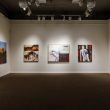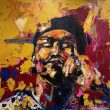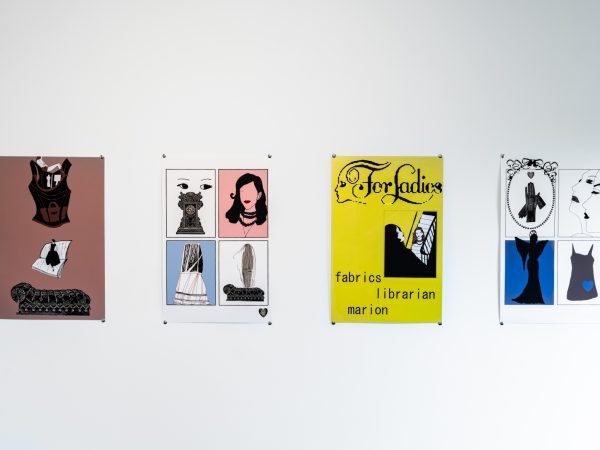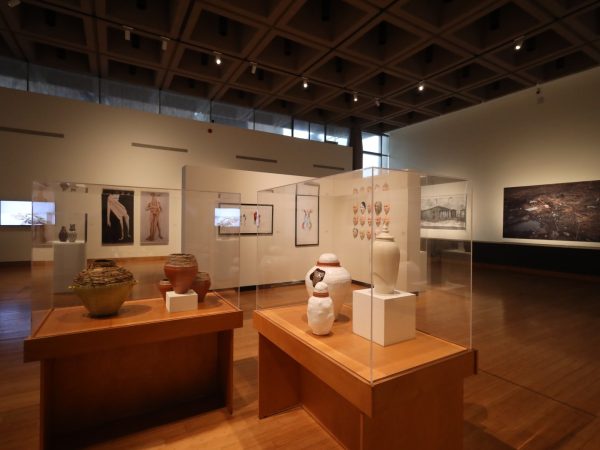On July 9, 1975, Dutch conceptual and performance artist Bas Jan Ader left Cape Cod in a thirteen-foot boat on a solo voyage across the North Atlantic never to reach his destination. Ader’s final work left him lost at sea. Nearly fifty years later, artist Will Robinson invites viewers to sit in this grief and honour his disappearance.
Just outside the entrance of Saint Mary’s University Art Gallery a student is seated, folding their laundry. The nervous energy of university students yelling in the hallways makes it all the more jarring to enter the dark gallery and the sombre tone inside. The moment the doors close the laughter and yelling is replaced by the sounds of Pitchpole, creating an immediate shift sonically into something more spiritual.
In the centre of the gallery sits a large circular platform with a plush black rug on the top. Centred in the rug is a large jar holding two pickled eggs floating awkwardly in the middle. The wall parallel plays a large-scale video on loop. The platform is full of contradictions. As the centrepiece of the gallery it feels authoritative and important, but the carpet also evokes a black hole. It appears to be an altar to be worshiped at, but its bottled eggs centrpiece feels like a decade-old snack long forgotten at a dive bar. This is perhaps what Robinson does best. He boils down the elements of ritual and spirituality so the viewer can get to the feeling, without quite understanding the path they took there.
The gallery staff person mentions to me how viewers have been trying their best to approach the work with reverence. A sombre mood sits in the air at all times, and the opening feels like a wake or a ceremonial passage. I can understand why it would take a little encouragement to step onto the platform despite signage telling me to do so. The work feels important and I don’t want to intrude. Even if I did step on it, would I fall deep into the black hole, engulfed by the reverberations from the circle of speakers surrounding it?
I step up a few inches onto the platform and my entire eyeline is taken over by the video. The speakers are surrounding my body, and I feel small. I stand. I sit. I lie down. Quickly my self-consciousness about how one should interact with the platform slips away. Instead, I am noticing the vibrations of the sound hitting my body. The audio is an adaptation of Henry Russell’s 1838 musical composition “A Life On The Ocean Wave,” a song Ader had planned to incorporate into his arguably unfinished final performance. The voices in the choir gain volume, louder and louder until I become unaware that there is someone else in the room, or if I’m even in the room. I feel a genuine sense of loss for a man I had not heard of prior to entering the gallery. The screen displays text: “Mama, cuddles? My arms, the place of burial,” and I start to cry.
The following day as I walked through the gallery with Robinson, I got the impression that my viewing was successful to him. Perhaps if the gallery reported to him the numbers of viewers who felt something in their chest or who lingered a little too long instead of attendance numbers he would be pleased. Not as a gotcha—made you feel something! but because he possesses a deep earnestness and values deep feeling with a sincerity I don’t come across often. Robinson seems happy to just have the chance to facilitate the space.
Space seems particularly important to Robinson’s practice. Like much of his previous works, Pitchpole is site-specific; it was made for SMU Gallery. Many of his past works, including Young Prayer (2011) and Sun Ship Machine Gun – Metallurgy I (2015), have been installed in churches. Throughout the video component of Pitchpole, Robinson’s performers—singers, pianists, and preparitors—populate the two main spaces of the Cathedral Church of All Saints in Halifax and the gallery itself. The video’s rich grey-scale palette elevates the galley to a more spiritual place. A grand piano is placed between the clunky, square, utilitarian pillars in the centre of the gallery, which in a way becomes a sister to the church altar in the next film scene.
Scattered throughout the gallery are physical relics from the video, including two mirrors, the top of the piano, and jewellery created by Shaya Ishaq, commissioned by Robinson for this exhibition. Tucked in the gallery’s side room, the grand piano is also featured and used in the performance. The piano top is off, and the mirrors are hanging askew above it, giving an even more explicit look inside. On the strings sits a conch, two hollow eggs, and a vase full of water with two egg cups floating inside. A large rock sits on one piano pedal, allowing the strings to absorb the rising sound of the choir in the next room. On the rock is a wax form of Robinson’s own ear, as if to gesture someone is always in the gallery listening. The items have been moved around, and he begins to move them back to a more pleasing arrangement. I ask if that’s allowed, and Robinson tells me I can touch them. My fingers reach out to touch a string, but it’s too much and I can’t bring myself to do it. Robinson seems open to collaboration in every aspect of his work, even if it’s from audience intervention, but the deep consideration given to every aspect of the installation seems too intimidating to infringe upon.
If the church is a display of God’s glory, Pitchpole is a display of conceptual art’s glory. Poetry by Erin Langille (acting as a psalm), Pitchpole (the hymn), jewellery by Shaya Ishaq (the relic), a sturdy set of speakers (the organ), and Ader (the saint). Does it matter that we don’t know the story of Ader and his ill-fated journey, or the many legends that have surrounded him since? Or is Ader’s story simply Robinson’s invitation to work through whatever unfinished grief we hold in the cathedral of the contemporary art gallery?









Leave a Reply